Arlington Arts Center in Arlington, VA, has a controversy-stirring exhibition up right now called She's So Articulate: Black Women Artists Reclaim the Narrative. The title instantly provokes discussion, as the word "articulate" has been particularly abused this election season. This term is often lobbed as a means of backhandedly complimenting African-Americans who excel in professional and social arenas for, in essence, not being too black.
Further debate is prompted by the curators' invocation of Kara Walker, a major artist by any measure and one who is not represented in the exhibition, as a foil against whose influence the artists in this show have been assembled. The argument they make is that Walker's rapid and prolonged success within the international art market has caused her dystopic vision of the sublimated racial assumptions that drive American society to become the only point of view on race admitted by contemporary art gatekeepers, and that she is therefore in possession of a power that ought to be subverted.
Because it is late and there are many intriguing artists in this show whose work you should see, I will divide this post into two parts. Tonight's post will cover the artists in the exhibition, while tomorrow's will address the curatorial strategies behind the show as well as include my commentary on Walker's perceived impact.
Torkwase Dyson, Oil and Fauna Don't Mix, and What Will Happen if I Don't..., both 2008
Torkwase Dyson tops my list of exciting local discoveries on this trip to the DC area. Regrettably I have not been able to see her concurrent two-person show at Meat Market Gallery in Washington, but her two installations at AAC knocked me out. Dyson employs the popular strategy of creative reuse in her work, using leftover parts of mass-produced commodities such as the plastic cards on which earrings are sold. The objects she selects connect the experiences of people of color with the global movement of goods, while drawing attention to wasteful practices and promoting eco-political engagement. Meanwhile, the visuals she creates are epic monster fantasias, their rich, glossy surfaces suffused with glitter. The seductive energy of her imagery and its comic bent prevent Dyson's material politics from overwhelming the work.
lauren woods, The Teenth of June, 2006
San Francisco-based filmmaker and artist lauren woods contributes two works to the exhibition. The Teenth of June commemorates the selection of Shilah Phillips as the first African-American Miss Texas in June 2006, with a title that is a play on "Juneteenth," a celebration of the legal end of slavery in its last vestige, Galveston, TX, in June 1865. woods views herself as a researcher, seeking out the spaces within images where the preconceptions of viewers come into play and create meaning. Without historical context, one might read the slowed-down pageant footage with its incongruous science-fiction soundtrack as foreboding, noticing the moments when Phillips seems isolated or obscured on the stage of otherwise white Texan beauty queens. An understanding of the title or of the racial history of Texas might lend the work a more joyous feeling. woods does not direct these interpretations.
lauren woods, (S)Port of San Francisco, 2006
(S)Port of San Francisco is a three-channel projection of original footage woods shot of performers at waterfront tourist spots in that city. The performers, all black men, weave in and out of frame, dancing with shirtless fury for the benefit of a mostly white audience. Their exuberance is unmatched by the stodgy observers, who watch politely but with visible discomfort. This dynamic can easily be read as that of a contemporary minstrel show, or it might simply be a movement study of these skillful dancers in action. The unacknowledged akwardness of the tourist experience also comes into play. woods' work is included in Bay Area Now 5 at San Francisco's Yerba Buena for the Arts, which I will attend and report on in August.
Renee Stout, The Thinking Room, 2005/08
Photographer and installation artist Renee Stout has created a body of work that explores the biography of her alter ego Fatima Mayfield. Fatima is a community healer steeped in the traditions of Caribbean herbalists, a "rootworker" who cures ailments and tells fortunes. Her place within her urban black neighborhood is contentious, her neighbors alternately enticed by her skills and resentful of their un-Christian origins. Stout tells Fatima's story in a slideshow of black-and-white stills and text, installed within an environment constructed from the trappings of Fatima's world. DC-based Stout has had a substantial career including a mid-career traveling retrospective in 2002, and is represented by Hemphill Fine Arts.
Nekisha Durrett, Jeri in the Woods, from Their Eyes Were Watching Everything, 2008
Finally (for now), Nekisha Durrett's manga-inspired paintings mounted behind shaped plexiglas were among my favorite objects in the show. Durrett's installation is derived from Japanese scrolls known as the Choju-Jinbutsu-Giga Emaki (“Frolicking Animals and People”), which date back roughly 1000 years and are credited as the origins of Japan's comic art tradition. Durrett draws as well on contemporary art and animation, showing the influences of master animation director Hayao Miyazaki and Neo-Pop art superstar Takashi Murakami. Her characters are drawn from people and animals important in her own life. Though her installation promotes a linear reading of the images within, the cheerful ambiguity of her work upends its narrative qualities. Also, it is just plain ridiculously cute. Durrett shows with Charles Guice Contemporary.
A complete set of images from the show can be seen here.

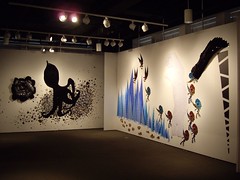
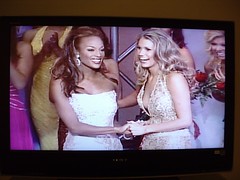
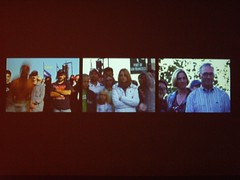
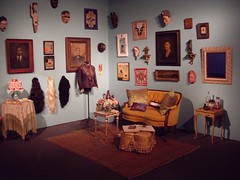
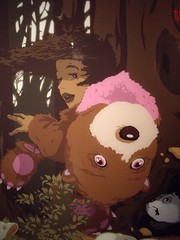

No comments:
Post a Comment